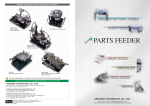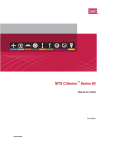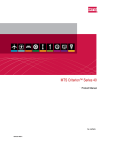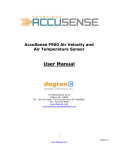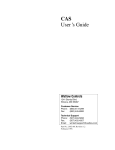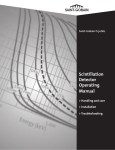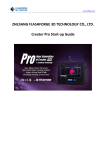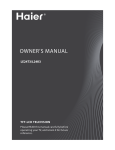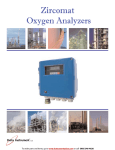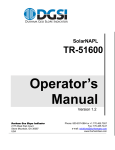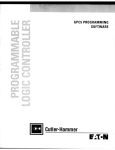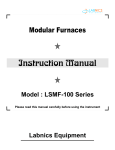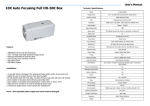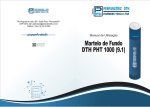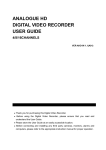Download FGW900 High-temperature Furnace
Transcript
FGW900 High-temperature Furnace Manual Title Additional Information Product Manual be certain. 100-231-447 A Copyright information Trademark information Publication information 2 © 2012 MTS Systems Corporation. All rights reserved. MTS is a registered trademark and MTS Criterion and MTS Insight are trademarks of MTS Systems Corporation within the United States. These trademarks may be protected in other countries. MANUAL PART NUMBER PUBLICATION DATE 100-231-447 A May 2012 FGW900 High-temperature Furnace Product Manual Contents Preface 5 Before You Begin Conventions 5 6 Documentation Conventions 6 Technical Support 7 How to Get Technical Support 7 Before You Contact MTS Service Representative If You Contact MTS by Phone After you call 7 8 9 Introduction 10 About This Manual Description 10 11 Furnace 12 Temperature controller 12 Bracket of high temperature furnace Operating condition requirements Technical parameters 12 13 13 Safety Information 14 Safety 14 Hazard Placard Placement 14 Installation 16 High temperature furnace body installation 17 High-Temperature Furnace Cable Connections 20 Operation 25 Operation of High Temperature Furnace 26 FGW900 High-temperature Furnace Product Manual Contents 3 Operation of Temperature Controller 28 Routine Maintenance 34 Routine Maintenance Overview Checklist 34 Declaration of Conformity 36 4 Contents FGW900 High-temperature Furnace Product Manual Before You Begin Preface Before You Begin Safety first! Other MTS manuals Before you use your MTS product or system, read and understand the safety information provided with your system. Improper installation, operation, or maintenance can result in hazardous conditions that can cause severe personal injury or death, or damage to your equipment and specimen. Again, read and understand the safety information provided with your system before you continue. It is very important that you remain aware of hazards that apply to your system. In addition to this manual, you may receive additional manuals in paper or electronic form. Manuals located on the product information CD will contain information that pertains to your test system, such as: • Hydraulic and/or mechanical accessory manuals • Assembly drawings • Parts lists • Operation instructions • Preventive maintenance tasks Controller and application software manuals are typically included on the software CD distribution disc(s). FGW900 High-temperature Furnace Product Manual Preface 5 Conventions Conventions Documentation Conventions The following paragraphs describe some of the conventions that are used in your MTS manuals. Hazard conventions Hazard notices may be embedded in this manual. These notices contain safety information that is specific to the activity to be performed. Hazard notices immediately precede the step or procedure that may lead to an associated hazard. Read all hazard notices carefully and follow all directions and recommendations. Three different levels of hazard notices may appear in your manuals. Following are examples of all three levels. DANGER Danger notices indicate the presence of a hazard with a high level of risk which, if ignored, will result in death, severe personal injury, or substantial property damage. WARNING Warning notices indicate the presence of a hazard with a medium level of risk which, if ignored, can result in death, severe personal injury, or substantial property damage. CAUTION Caution notices indicate the presence of a hazard with a low level of risk which, if ignored, could cause moderate or minor personal injury or equipment damage, or could endanger test integrity. Notes Notes provide additional information about operating your system or highlight easily overlooked items. For example: Note Special terms Illustrations Electronic manual conventions 6 Preface Resources that are put back on the hardware lists show up at the end of the list. The first occurrence of special terms is shown in italics. Illustrations appear in this manual to clarify text. They are examples only and do not necessarily represent your actual system configuration, test application, or software. This manual is available as an electronic document in the Portable Document File (PDF) format. It can be viewed on any computer that has Adobe Acrobat Reader installed. FGW900 High-temperature Furnace Product Manual How to Get Technical Support Technical Support How to Get Technical Support Start with your manuals The manuals supplied by MTS provide most of the information you need to use and maintain your equipment. If your equipment includes software, look for online help and README files that contain additional product information. If you cannot find answers to your technical questions from these sources, you can use the Internet, e-mail, telephone, or fax to contact MTS for assistance. Technical support methods Outside the U.S. MTS provides a full range of support services after your system is installed. If you have any questions about a system or product, contact Technical Support in one of the following ways. For technical support outside the United States, contact your local sales and service office. For a list of worldwide sales and service locations and contact information, use the Global MTS link at the MTS web site: www.mts.com > Global MTS > (choose your region in the right-hand column) > (choose the location closest to you) Before You Contact MTS Service Representative MTS can help you more efficiently if you have the following information available when you contact us for support. Know your contact number and system number The contact number contains your company number and identifies your equipment type (such as material testing or simulation). The number is typically written on a label on your equipment before the system leaves MTS. If you do not know your MTS contact number, contact your sales engineer. When you have more than one MTS system, the system model number and series number identifies your system. You can find your these number in your order paperwork or directly on your equipment. Identify the problem Describe the problem and know the answers to the following questions: • How long and how often has the problem occurred? • Can you reproduce the problem? • Were any hardware or software changes made to the system before the problem started? • What are the equipment model numbers? • What is the controller model (if applicable)? • What is the system configuration? FGW900 High-temperature Furnace Product Manual Technical Support 7 If You Contact MTS by Phone Know relevant computer information Know relevant software information For a computer problem, have the following information available: • Manufacturer’s name and model number • Operating software type and service patch information • Amount of system memory • Amount of free space on the hard drive where the application resides • Current status of hard-drive fragmentation • Connection status to a corporate network For software application problems, have the following information available: • The software application’s name, version number, build number, and (if available) software patch number. This information can typically be found in the About selection in the Help menu. • The names of other applications on your computer, such as: – Anti-virus software – Screen savers – Keyboard enhancers – Print spoolers – Messaging applications If You Contact MTS by Phone A Call Center agent registers your call before connecting you with a technical support specialist. The agent asks you for your: • Contact number • Name • Company name • Company address • Phone number where you can be reached If your issue has a notification number, please provide that number. A new issue will be assigned a unique notification number. FGW900 High-temperature Furnace Product Manual Technical Support 8 After you call Identify system type Be prepared to troubleshoot Write down relevant information To enable the Call Center agent to connect you with the most qualified technical support specialist available, identify your system as one of the following types: • Electromechanical material test system • Hydromechanical material test system • Vehicle test system • Vehicle component test system • Aero test system Prepare to perform troubleshooting while on the phone: • Call from a telephone close to the system so that you can implement suggestions made over the phone. • Have the original operating and application software media available. • If you are not familiar with all aspects of the equipment operation, have an experienced user nearby to assist you. In case Technical Support must call you: • Verify the notification number. • Record the name of the person who helped you. • Write down any specific instructions. After you call MTS logs and tracks all calls to ensure that you receive assistance for your problem or request. If you have questions about the status of your problem or have additional information to report, please contact Technical Support again and provide your original notification number. FGW900 High-temperature Furnace Product Manual Technical Support 9 About This Manual Introduction About This Manual Purpose The FGW900 High Temperature Furnace provides a high-temperature testing environment for material tests. These tests can include tension, compressing, or bending of ceramic, metal, and compound materials. This manual provides technical information about the high-temperature furnace in terms of its parts, working environment, technical parameters, temperature controller, installation, and operation. Inappropriate Use Before you attempt to use the FGW900 MTS High Temperature Furnace, read and understand this manual. Improper installation or operation of this product can result in hazardous conditions that can cause sever personal injury or death, and damage your equipment and specimen. Contents Description 11 Operating condition requirements Technical parameters FGW900 High-temperature Furnace Product Manual 13 13 Introduction 10 Description Description The FGW900 High Temperature Furnace is primarily used with the MTS Series C45 Electronic Universal Testing Machine and the MTS Series C64 StaticHydraulic Universal Testing Machine. It provides the high temperature required for tension tests while providing a long-term, stable, high-temperature testing environment. The MTS Series FGW900 High furnace let you test materials and components within a range of temperatures, from 300~ 1100°C (572 ~ 2097°F). Heating is accomplished with electrical heating elements. A customer-specified temperature controller (Eurotherm2408) is mounted in the electrical box. The high temperature furnace provides stable test temperature conditions for high temperature tension tests. The high temperature furnace consists of a bracket, furnace body, temperature controller, rod. Furnace Rod Mounting Brackets Furnace Typical installation of high temperature furnace 11 Introduction FGW900 High-temperature Furnace Product Manual Furnace Furnace The high-temperature furnace opening provides quick sample and fixture installation. The furnace has ports used for connecting thermocouples and hightemperature extensometers. The cavity of the furnace uses thermal insulation material of multicrystal mullite fiber, allowing operation at maximum temperature for extended periods of time. The heating body is made of electro thermal alloy wire which provides fast temperature rise, low heat loss, and long service life. The housing is made of stainless steel in a double layer structure, ensuring a lower surface temperature. Temperature controller The high temperature furnace is monitored and controlled by the temperature controller. The temperature controller has three high-precision Eurotherm temperature control meters which control three heating zones. Each temperature control meter receives the input from a thermocouple and outputs power accordingly to its heating element. Solid-state relays are used to meet the requirements of high-precision temperature control. Controller Furnace Upper Control Signal Heating Element Middle Control Signal Heating Element Lower Control Signal Heating Element LowerThermocouple Signal Middle Thermocouple Signal Upper Thermocouple Signal High temperature furnace control diagram Bracket of high temperature furnace The bracket for the furnace has an adjustable rotary bracket that allows you toadjust the position of the furnace or easily remove it from the test space. FGW900 High-temperature Furnace Product Manual Introduction 12 Operating condition requirements Operating condition requirements Only use the high temperature furnace under the following conditions. PARAMETER SPECIFICATION Condition For indoor application only Operating Temperature 5 ~ 40 °C (41 ~ 104 °F) Operating Humidity 5-85%, noncondensing Maximum Altitude 2000 m (6562 ft) Voltage Single-phase AC 200 ~ 240 V Frequency 50 Hz / 60 Hz Current 15 Amps Technical parameters 13 MODEL FGW900 Scope of application C45, C64 Temperature scope (°C) 300 ~ 1100(572 °F to 2097 °F) External dimension (mm) Φ310 x 410(12.2 in x 16.1 in) Dimension of chamber (mm) Φ100 x 320(3.9 in x 12.6 in) Controller size (mm) 400 x 420 x 200(15.7 in x 16.5 in x 7.9 in) Uniform temperature zone length(mm) 100(3.9 in) Temperature gradient ≤3°C(≤37.4 °F) Heating method Three-segment controllable Temperature fluctuation ≤± 2°C(≤35.6 °F) Precision of temperature controller Class 0.3 Time to obtain operating temperature ≤50 min Weight 25 kg(55.1lb) Introduction FGW900 High-temperature Furnace Product Manual Safety Safety Information Safety Stay clear of moving equipment/avoid crush points Stay clear of mechanical linkages, connecting cables, and hoses that move because you can get pinched, crushed, tangled, or dragged along with the equipment. High forces generated by the system can pinch, cut, or crush anything in the path of the equipment and cause serious injury. Stay clear of any potential crush points. Most test systems can produce sudden, high-force motion. Never assume that your reactions are fast enough to allow you to escape injury when a system fails. Know the causes of unexpected crosshead motions The high force and velocity capabilities of MTS systems can be destructive and dangerous (especially if crosshead motion is unexpected). The most likely causes of unexpected crosshead response are operator error and equipment failure due to damage or abuse (such as broken, cut, or crushed cables and hoses; shorted wires; overstressed feedback devices; and damaged components within the control loop). Eliminate any condition that could cause unexpected crosshead motion. Do not use RF transmitters Keep radio frequency (RF) transmitters away from the workstation computers, remote terminals, and electronics consoles. Intense RF fields can cause erratic operation of the more sensitive circuits in the system. Hazard Placard Placement Hazard placards contain specific safety information and are affixed directly to the system so they are plainly visible. Each placard describes a system-related hazard. When possible, international symbols (icons) are used to graphically indicate the type of hazard and the placard label indicates its severity. In some instances, the placard may contain text that describes the hazard, the potential result if the hazard is ignored, and general instructions about how to avoid the hazard. The following labels are typically located on the chamber. LABEL DESCRIPTION High temperature Furnace ID label. Series FEC Environmental Chamber Product Manual Safety Information 14 Hazard Placard Placement LABEL DESCRIPTION Do not start, operate, or service machine until you read and understand the operator’s manual. Failure to do so could result in serious injury. There are no customerserviceable parts on the MTS Criterion electromechanical frames. Burn hazard. Hot surface. Do not touch. Allow to cool before servicing. Hot surface hazard. Do not touch. 15 Safety Information Series FEC Environmental Chamber Product Manual Installation The FGW900 High-Temperature Furnace is usually provided for the customer as an accessory of a main machine, and MTS service staff installs the accessory following defined steps. If it was purchased as a replacement or an additional item, install it following the steps described in this section. Installation Overview The following is an overview of furnace installation tasks: 1. Mount the furnace on the load frame. 2. Connect all electrical cables and jumpers. 3. Install the extensometer. The extensometer, if used, is mounted independently and its extension rods extend into the furnace through an opening filed in the front of the furnace. Mounting Considerations Consider the following when mounting the furnace in the load frame: 1. When mounting ensure the specimen rod axis is in coincidence with the furnace hearth axis. 2. When mounting ensure the vertical center of the specimen is in coincidence with the vertical center of the high-temperature furnace. FGW900 High-temperature Furnace Product Manual Installation 16 High temperature furnace body installation High temperature furnace body installation Furnace body installation steps: 1. Unplug the furnace rotation axis from the hinge assembly of the furnace 2. Put the furnace onto the bracket 3. Align the high-temperature furnace hinge holes with the bracket mounting holes; 4. Downwards insert the rotation axis , connect the high temperature furnace with the high-temperature bracket, as shown below: Axis of Rotation Bracket 5. Furnace door switch installation As the door switch has been adjusted in the right position in the vendor's plant, users are not allowed to arbitrarily adjust the position when installing the furnace for the first time. If need to replace the switch, you need follow the below steps: FGW900 High-temperature Furnace Product Manual Installation 17 High temperature furnace body installation 5.1 Assemble the contact block and limit switch separately based on the following figure shows: Screw Pressing Block Touch Arm Touch Base Screw Door Switch Backing Plate Door Switch Base FGW900 High-temperature Furnace Product Manual Installation 18 High temperature furnace body installation 5.2 According to the following figure shows, assemble the contact block whole piece and limit switch whole piece to the furnace bottom front position. Furnace Bottom Door Switch Assembly Touch Assembly 5.3 Use 2 Metric M4X10 socket head cap screws to lock the contact assembly piece, and then move the door switch assembly piece to make the door switch closed, after that, mover forward another 0.5mm to lock the four screws in the door switch assembly piece. c. Lock the door switch assembly four screw. b. Moving door switch assembly so that the door switch is closed, then moving forward with 0.5mm. a. First ,lock touch assembly. FGW900 High-temperature Furnace Product Manual Installation 19 High-Temperature Furnace Cable Connections High-Temperature Furnace Cable Connections The connection between the high-temperature furnace and the temperature controller is shown as below: FGW900 High-temperature Furnace Product Manual Installation 20 High-Temperature Furnace Cable Connections Connection steps: 1. Connect the thermocouple wire Aaccording to the label sequence of J8, J9, and J10, insert thermocouple into the upper, middle, lower jacks of the high temperature furnace side wall and tighten the fixing screws. Insert the cable that is carried by the thermocouple into the thermocouple outlet on the rear panel of the temperature controller. To Furnace Body 2. Connect the door switch wire Insert one end of switch lead with plug into J7 jack of the temperature controller, then connect the other end to the limit switch contact on the furnace bottom. When installing, the furnace door switch lead has been connected together with the limit switch. Only need to insert the other end to J7 of the temperature controller. 3. Connect the output power cable between the furnace and the temperature controller. There are two power cables that connect the furnace and the temperature controller. One is OUTPUTL, the other is OUTPUT N. The two cables have already been connected together on the furnace. When installing, simply need to follow the labels to insert one end with plug into the corresponding sockets on the rear panel of the temperature controller and then tighten the fastens. Note Do not insert or unplug this connectors group in the heating condition to avoid personal electric shock accidents. FGW900 High-temperature Furnace Product Manual Installation 21 High-Temperature Furnace Cable Connections Lock Fastener Insert Socket 4. Connect E-STOP to the frame When connecting insert one end of E-STOP cable with E-STOP IN label into ESTOP IN socket in the rear panel of the temperature controller, then put the other end into E-STOP jack J14 on the frame controller. More detailed information about E-STOP, see related contents in the MTS load frame manual. 5. Connect the communication cable to the computer There is a reserved port J6 on the temperature controller of the furnace. When needs to connect the computer and the temperature controller, a MTS communication cable is required. It is through a 485 to use serial converter to achieve the connection. FGW900 High-temperature Furnace Product Manual Installation 22 High-Temperature Furnace Cable Connections Temperature Controller Box Computer Serial Converter Communication cable for connection FGW900 High-temperature Furnace Product Manual Installation 23 High-Temperature Furnace Cable Connections Connecting the Main Power The input voltage of the MTS FGW900 high temperature Furnace is single phase 200-240 V, 50/60 Hz. Use the cable that is provide for power input, and connect to the customer electrical box and disconnect. Note Electrical disconnect Local electrical codes supercede any information found here. Electrical connections must be made by qualified personnel and is their responsibility for using the proper power disconnect that conforms to local codes and regulations when connecting the machine to the building main power. The customer is responsible for providing an electrical power disconnect that is easy to operate and easy to reach. It must also meet IEC 60947-1 and IEC 609473 standards. Recommended circuit breaks would be ones that are of the thermal magnetic type with characteristics suitable for large inductive loads(D-type trip characteristic). If fuses are used it is recommended that they are of the time delay type with dual elements. These recommendations should be followed to avoid nuisance tripping. Connected to the Customer Electrical Box and Disconnect FGW900 High-temperature Furnace Product Manual Installation 24 Operation This section provides typical operating instructions for the high-temperature furnace along with safety requirements. For more details about the software and the Eurotherm temperature controller, see the software operation manual and the Eurotherm temperature controller manual. Contents Operation of High Temperature Furnace Operation of Temperature Controller 26 28 CAUTION Abrasion of insulation inserts produces airborne dust. Airborne dust from the insulation can irritate the eyes, lungs, and skin. Use eye protection (goggles), gloves, and a high efficiency respirator if it is necessary to work with insulating materials. FGW900 High-temperature Furnace Product Manual Operation 25 Operation of High Temperature Furnace Operation of High Temperature Furnace Before starting test,you need assemble high temperature grip, open high temperature furnace and revolve it into test space, assemble high temperature grip into furnace body and seal pull rod hole according to requirement. The high temperature furnace belongs to split flange high temperature furnace, of which opening/closing is realized via lock on external wall of case shell. The bottom of the high temperature furnace is equipped with a limit protection switch, when the high temperature furnace is opened, this limit protection switch will cut off the heating power, and can not self-recovery, only when to again press the ENABLE button can be connected to the heating circuit once the door is closed again. Furnace Handle Thermocouple Hole Furnace Lock Extensometer Channel If you use a high-temperature extensometer (supplied separately), its extension guide rod is inserted into the furnace via the slot for the extensometer in front of the furnace and contacts the testing sample. For information about the installation and usage of the high-temperature extensometer, see the high-temperature extensometer user manual. FGW900 High-temperature Furnace Product Manual Operation 26 Operation of High Temperature Furnace WARNING Improper use can shorten the life of heater elements and insulation components. Do not open the high-temperature furnace while it is hot or operating. Allow sufficient time for the furnace to cool before opening the furnace. Rapid cooling reduces heating element life. WARNING Do not use this furnace to heat materials that pose hazards of explosion, implosion, or the release of toxic or flammable gases Explosions in the furnace can cause death or serious injury. WARNING Do not operate the furnace near or above flammable materials. Allow sufficient time for the test materials to cool before handling them. Materials heated in the furnace are hot and can ignite flammable materials or cause serious burns. Do not operate the furnace near or above flammable materials. Allow sufficient time for the test materials to cool before handling them. WARNING Do not use the metal shell of the thermocouple when replacing the thermocouple. Six groups of 230V AC heating wires were buried in furnace inner wall; when thermocouple pass through the heating wires, the mental shell of thermocouple may be charged, resulting in equipment damage or electric shock injury. Do not use the metal shell of the thermocouple; you should use a porcelain jacket tube thermocouple. FGW900 High-temperature Furnace Product Manual Operation 27 Operation of Temperature Controller Operation of Temperature Controller The temperature controlling system of high temperature furnace allows user to connect it with the computer and set software parameters. The function of the switch and interface . FUNCTION DESCRIPTION Starts the heating Disables (stops) the heating POWER: Power switch of the temperature controller. COMM.: Communication interface. Furnace connects with the computer via this interface. The required temperature and parameters can be set for a test via this interface. Temperature information can be read through software in real time. FGW900 High-temperature Furnace Product Manual Operation 28 Operation of Temperature Controller The interface use 9 pins connectors and three of them are used. Pin assignments are as follows: PIN SIGNAL 1 No Contact 2 COMM A(+) 3 COMM B(-) 4 Communication GND 5 No Contact 6 No Contact 7 No Contact 8 No Contact 9 No Contact E-STOP: The J1 connector should be connected to either J14 of the Frame Controller or J2 of another Accessory with an Emergency Stop board. The J2 connector will either have a jumper plug or be connected to J1 of another Accessory with an Emergency Stop board. J1 E-STOP pin assignments are as follows: PIN SIGNAL 1 ESTOP3B- 2 No Contact 3 No Contact 4 ESTOP_OUT_MONTION+ 5 ESTOPB_IN+ 6 ESTOP3A- 7 ESTOPB_IN- 8 ESTOPA_IN+ 9 ESTOP3B+ 10 ESTOP_OUT_MONTION- 11 No Contact 12 No Contact 13 ESTOPA_IN- 14 ESTOP3A+ 15 No Contact FGW900 High-temperature Furnace Product Manual Operation 29 Operation of Temperature Controller J2 E-STOP pin assignments are as follows: PIN SIGNAL 1 ESTOPB_OUT- 2 No Contact 3 ESTOP_OUT_MONTION- 4 ESTOP_OUT_MONTION+ 5 ESTOP3B+ 6 ESTOPA_OUT- 7 ESTOP3B- 8 ESTOP3A+ 9 ESTOPB_OUT+ 10 No Contact 11 No Contact 12 No Contact 13 ESTOP3A- 14 ESTOP_OUT+ 15 No Contact J4 pin assignments are as follows: PIN SIGNAL 1 Upper heating L 2 Middle heating L 3 Lower heating L 4 GND 5 No Contact 6 No Contact High temperature furnace heating wire N (OUTPUT N): the heating wire of hightemperature furnace temperature controller N connects the plug-in components. The socket connects the heating wire on the furnace of N-line side. J5 pin assignments are as follows: PIN SIGNAL 1 No Contact 2 No Contact FGW900 High-temperature Furnace Product Manual Operation 30 Operation of Temperature Controller PIN SIGNAL 3 GND 4 Upper heating N 5 Middle heating N 6 Lower heating N The thermcouples interface (THERMCOUPLE)The three thermocouples on the furnace are connected to the socket.J8, J9, J10 plug into the upper, middle and lower segment of the thermocouple. Furnace door switch: When the door is open, cut off the limit switch that's connected to the heating power on the furnace. This interface is a 9-pin connector, the pin function are as follows: PIN SIGNAL 1 No Contact 2 Connected to the 2408 AC Pin 3 Connected to the E-STOP Pin ES1 4 No Contact 5 No Contact 6 No Contact 7 No Contact 8 No Contact 9 No Contact FGW900 High-temperature Furnace Product Manual Operation 31 Operation of Temperature Controller Heating Output L Communication Interface Temperature Controller Common Functions E-STOP Heating Output N Thermocouple Interface Door Switch Interface Power Switch Power Input The Furnace uses a Eurotherm2408 as temperature controller. The following describes the operation of manual settings and some of its methods and procedures. For details relating to setting test temperature and various control parameters, refer to the attached "<<Models2404/2408 PID Controllers Installation and Operation handbook>>". For setting test temperature and control parameters via software, refer to the attached software application manual. 1. Setting test temperature Press or key directly to adjust the temperature FGW900 High-temperature Furnace Product Manual Operation 32 Operation of Temperature Controller The measured temperature Set temperature Increase and decrease key, is used to set the temperature and ginseng 2. Setting PID Control Parameters: PID control parameters are the key parameters to control the temperature. Generally, different temperatures require different PID parameters. When setting the temperature, refer to the corresponding information to enter the correct parameters. Based on parameters tables given in the Eurotherm manual to set three parameters, Pb (P parameter), ti (I parameter), and td (D parameter). The following flow chart briefly illustrates the methods to set the three parameters (PID). FGW900 High-temperature Furnace Product Manual Operation 33 Routine Maintenance Routine Maintenance This section provides information regarding service of the high-temperature furnace. Routine Maintenance Overview Checklist Recommended Service CALENDAR TIME USING 8 HOURS RUNNING TIME RATE DAILY WEEKLY ANNUALLY Running time-hours 8 40 2000 Clean the furnace inside/furnace surface area X PER DAY Check the door swith and E-STOP X Check the cable connection X Check all the buttons function X System Inspection Check the cable connection MTS System Cherks Check E-STOP MTS Check the door switch MTS WARNING The surface of the furnace can become extremely hot. Touching the furnace before it has cooled can severly burn skin. Allow sufficient time for the furnace to cool off before servicing the furnace. FGW900 High-temperature Furnace Product Manual Routine Maintenance 34 Routine Maintenance • When using the furnace, try not to make contact with the inner cavity of the furnace during the process of installing a test sample to avoid causing damage to the furnace cavity. • Do not open the furnace immediately after a test is completed to avoid serious injury and prevent damage to the furnace cavity. • Clean the furnace cavity in a timely manner with a soft brush once a test is completed in order to prolong the service life of the furnace. • If the furnace is not used for a long period, preheat the furnace before using it again. The preheating method is as follows: 1. Increase the temperature to 200°C and maintain that temperature for a least four hours. 2. Increase the temperature to 400°C and maintain that temperature for a least four hours. 3. Increase the temperature to 600°C and maintain that temperature for a least four hours. Treatment of general fault FAULT CONDITION REASON SOLUTION SV window flashes and displays “S.br” The input measuring signal exceeds the measuring range 1. Check whether the specifications of the sensor are properly defined 2. Check whether the signal input is broken Heatup speed is slower than original speed The parameter are not properly defined Check whether the parameters of the temperature controller are properly defined The Temperature controller can not start the furnace The Furnace is not closed properly or there is something wrong with the Furnace door switch or cable 1.Check the furnace of see if it is closed properly Temperature fails to steady at setting temperature Control parameter is imperfect or lost Start self-adjustment to find out proper control parameter FGW900 High-temperature Furnace Product Manual 2.Check the door switch cable and the connections to the furnace door switch and the back of the temperature controller Routine Maintenance 35 Declaration of Conformity FGW900 High-temperature Furnace Product Manual Declaration of Conformity 36 37 Declaration of Conformity FGW900 High-temperature Furnace Product Manual m MTS Systems Corporation http://www.mts.com/en/Global/index.asp ISO 9001 Certified QMS









































